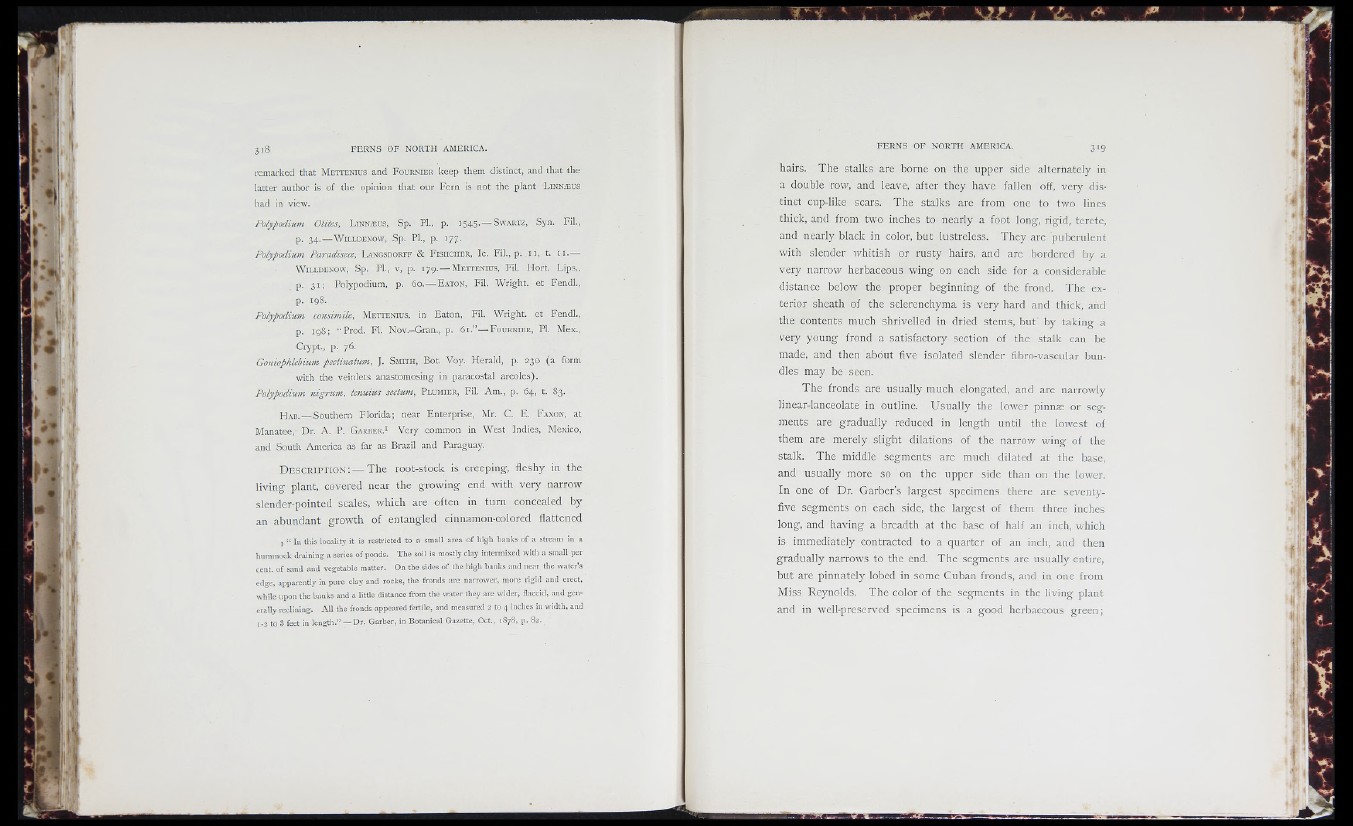
\ i k
: A •
p '1
r j -
1 ,1
t;
I t ■
r i i
C f f
« Id
’ ■ :,i
remarked that M e t t e n iu s and F o u r n ie r keep them distinct, and that the
latter author is of the opinion that our Fern is not the plant L in næ u s
had in view.
Polypodmm Otites, L in n æ u s , Sp. Pl.. p. 1545. — S w a r t z , Syn. Fil..
p. 3 4 .— W il ld en ow , Sp. PL, p. 17 7 .
Polypoditcm Paradiseoe, L a n g sd o r f f & F is h c h e r , I c. Fil., p. 1 1 , t. 1 1 .—
W il ld en ow , Sp. PL, v, p. 179. — M e t t e n iu s , Fil. Hort. Lips.,
p. 3 1 ; Polypodium, p. 6 0 .— E aton , Fil. Wright, et Fendl.,
p. 19 8 .
Polypodium consimile, M e t t e n iu s , in Eaton, Fil. Wright, et Fendl,
p. 198; “ Prod. FL Nov.-Gran., p. 6 1.” — F o u r n ie r , PL Mex.,
Crypt., p. 76.
Goniophlebium pectinatum, J. S m ith , Bot. Voy. Herald, p. 230 (a form
with the veinlets anastomosing in paracostal areoles).
Polypodium fiigrum, tenuius sectum, P l u m ie r , Fil. Am., p. 64, t. 83.
H a b .— Southern Florida; near Enterprise, Mr. C. E. F a xon , at
Manatee, Dr. A. P. G a r b e r .^ Very common in West Indies, Mexico,
and South America as far as Brazil and Paraguay.
D e s c r i p t i o n : — The root-stock is creeping, fleshy in the
living plant, covered near the growing end with very narrow
slender-pointed scales, which are often in turn concealed by
an abundant growth of entangled cinnamon-colored flattened
I “ In this locality it is restricted to a small area o f hig h banks o f a stream in a
hummock draining a series o f ponds. T h e soil is mostly clay inte rmixed w ith a small per
cent, o f sand and vegetable matter. On the sides o f the high banks and ne a r th e wa te r’s
edge, apparently in pu re clay an d rocks, th e fronds are na rrowe r, more rigid an d erect,
while u pon the banks and a little distance from th e w a te r they arc wide r, flaccid, an d g en erally
reclining. A ll the fronds appe a red fertile, and measured 2 to 4 inches in w id th , and
1-2 to 3 feet in len g th .” — D r. Garber, in Botanical Gazette, Oct., 1878, p . 82.
hairs. The stalks are borne on the upper side alternately in
a double row, and leave, after they have fallen off, very distinct
cup-like scars. The stalks are from one to two lines
thick, and from two inches to nearly a foot long, rigid, terete,
and nearly black in color, but lustreless. They are puberulent
with slender whitish or rusty hairs, and are bordered by a
very narrow herbaceous wing on each side for a considerable
distance below the proper beginning of the frond. The exterior
sheath of the sclerenchyma is very hard and thick, and
the contents much shrivelled in dried stems, but by taking , a
very young frond a satisfactory section of the stalk can be
made, and then about five isolated slender fibro-vascular bundles
may be seen.
The fronds are usually much elongated, and are narrowly
linear-lanceolate in outline. Usually the lower pinnæ or segments
are gradually reduced in length until the lowest of
them are merely slight dilations of the narrow wing of the
stalk. The middle segments are much dilated at the base,
and usually more so on the upper side than on the lower.
In one of Dr. Garber’s largest specimens there are seventy-
five segments on each side, the largest of them three inches
long, and having a breadth at the base of half an inch, which
is immediately contracted to a quarter of an inch, and then
gradually narrows to the end. The segments are usually entire,
but are pinnately lobed in some Cuban fronds, and in one from
Miss Reynolds. The color of the segments in the living plant
and in well-preserved specimens is a good herbaceous green;